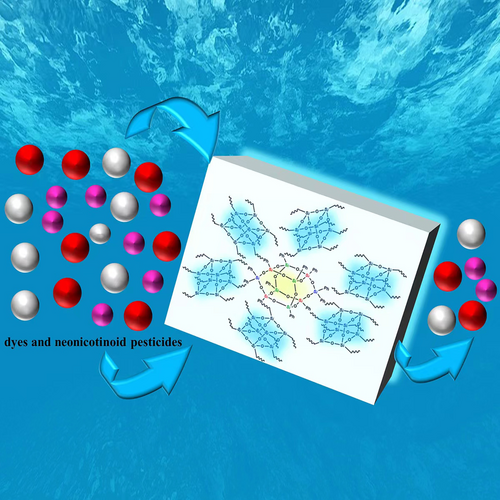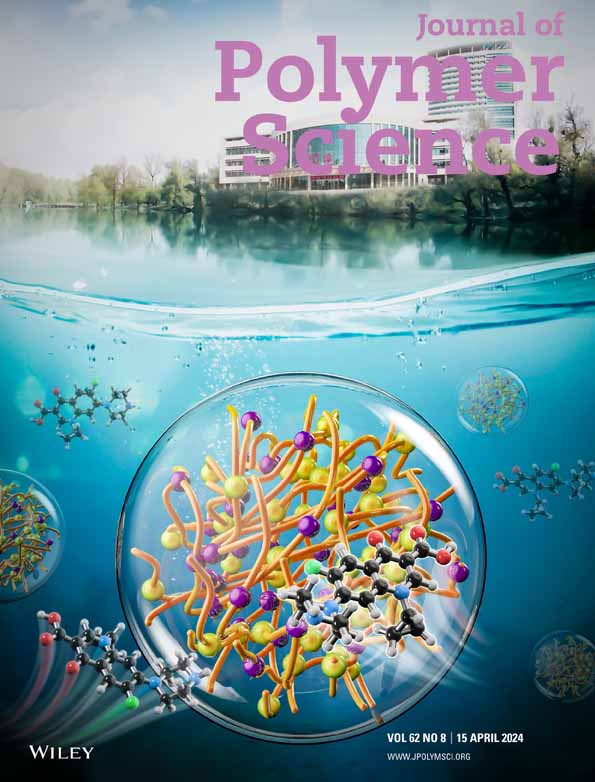Hybrid porous polymers based on double-decker and cage-ype silsesquioxanes for the high-efficiency removal of neonicotinoid insecticides and dyes
Xiaohan Zhao
International Center for Interdisciplinary Research and Innovation of Silsesquioxane Science, Key Laboratory of Special Functional Aggregated Materials, Ministry of Education, School of Chemistry and Chemical Engineering, Shandong University, Jinan, People's Republic of China
Search for more papers by this authorCorresponding Author
Hongzhi Liu
International Center for Interdisciplinary Research and Innovation of Silsesquioxane Science, Key Laboratory of Special Functional Aggregated Materials, Ministry of Education, School of Chemistry and Chemical Engineering, Shandong University, Jinan, People's Republic of China
Correspondence
Hongzhi Liu, International Center for Interdisciplinary Research and Innovation of Silsesquioxane Science, Key Laboratory of Special Functional Aggregated Materials, Ministry of Education, School of Chemistry and Chemical Engineering, Shandong University, Jinan, 250100, People's Republic of China.
Email: [email protected]
Search for more papers by this authorXiaohan Zhao
International Center for Interdisciplinary Research and Innovation of Silsesquioxane Science, Key Laboratory of Special Functional Aggregated Materials, Ministry of Education, School of Chemistry and Chemical Engineering, Shandong University, Jinan, People's Republic of China
Search for more papers by this authorCorresponding Author
Hongzhi Liu
International Center for Interdisciplinary Research and Innovation of Silsesquioxane Science, Key Laboratory of Special Functional Aggregated Materials, Ministry of Education, School of Chemistry and Chemical Engineering, Shandong University, Jinan, People's Republic of China
Correspondence
Hongzhi Liu, International Center for Interdisciplinary Research and Innovation of Silsesquioxane Science, Key Laboratory of Special Functional Aggregated Materials, Ministry of Education, School of Chemistry and Chemical Engineering, Shandong University, Jinan, 250100, People's Republic of China.
Email: [email protected]
Search for more papers by this authorAbstract
Different ratios of octavinylsilsesquioxane (OVS) reacted with phenyl-substituted double-decker silsesquioxane (Ph-DDSQ) via the simple Friedel-Crafts reaction provides several innovative silsesquioxane-based porous polymers (PCS-ODs). The hybrid polymers show adjustable porosity (specific surface areas of 1235 m2 g−1 and large pore volumes >1.07 cm3 g−1). FTIR, SEM, BET, TGA, solid-state 13C and 29Si MAS NMR spectra were employed to fully characterize these hybrid materials. They display good adsorption capacities for neonicotinoid insecticides (imidacloprid [IMI], acetamidine [ACE] and thiamethoxam [THI]), with capacities up to 117 ± 2, 70 ± 1 and 61 ± 4 mg g−1, respectively. Dyes (Congo red [CR] and rhodamine B [RB]) can also be sufficiently removed, the adsorption capacities are 1822 ± 4 and 912 ± 3 mg g−1. In addition, PCS-ODs can be cycled at least five times.
Graphical Abstract
CONFLICT OF INTEREST STATEMENT
The authors declare that they have no known competing financial interests or personal relationships that could have appeared to influence the work reported in this paper.
Supporting Information
| Filename | Description |
|---|---|
| pol20230244-sup-0001-Supinfo.docxWord 2007 document , 1.1 MB | Data S1: Supporting Information. |
Please note: The publisher is not responsible for the content or functionality of any supporting information supplied by the authors. Any queries (other than missing content) should be directed to the corresponding author for the article.
REFERENCES
- 1Q. Zhang, S. Hu, W. Dai, S. Gu, Z. Ying, R. Wang, C. Lu, Environ. Pollut. 2023, 320, 121082.
- 2X. Zhang, Y. Huang, W. Chen, S. Wu, Q. Lei, Z. Zhou, W. Zhang, S. Mishra, P. Bhatt, S. Chen, Environ. Res. 2023, 218, 114953.
- 3A. Tkaczyk, K. Mitrowska, A. Posyniak, Sci. Total Environ. 2020, 717, 137222.
- 4M. L. Sikosana, K. Sikhwivhilu, R. Moutloali, D. M. Madyira, Procedia Manuf. 2019, 35, 1018.
10.1016/j.promfg.2019.06.051 Google Scholar
- 5A. Saravanan, P. Senthil Kumar, S. Jeevanantham, S. Karishma, B. Tajsabreen, P. R. Yaashikaa, B. Reshma, Chemosphere 2021, 280, 130595.
- 6K. Rouibah, H. Ferkous, A. Delimi, T. Himeur, M. Benamira, M. Zighed, A. S. Darwish, T. Lemaoui, K. K. Yadav, J. K. Bhutto, A. Ahmad, S. Chaiprapat, Y. Benguerba, J. Environ. Manag. 2023, 326, 116742.
- 7X. Li, S. Lu, G. Zhang, J. Hazard. Mater. 2023, 445, 130524.
- 8M. Kumar, S. Sridharan, A. D. Sawarkar, A. Shakeel, P. Anerao, G. Mannina, P. Sharma, A. Pandey, Sci. Total Environ. 2023, 859, 160031.
- 9N. B. Singh, G. Nagpal, S. Agrawal, Rachna, Environ. Technol. Innov. 2018, 11, 187.
- 10M. Chen, Y. Zhang, Q. Xie, W. Zhang, X. Pan, P. Gu, H. Zhou, Y. Gao, A. Walther, X. Fan, ACS Biomater Sci. Eng. 2019, 5, 4612.
- 11M. Soldatov, H. Liu, Prog. Polym. Sci. 2021, 119, 101419.
- 12Y. Du, H. Liu, Dalton Trans. 2020, 49, 5396.
- 13Q. Ge, H. Liu, Chem. Eng. J. 2022, 428, 131370.
- 14Q. Wang, M. Unno, H. Liu, ACS Sustain. Chem. Eng. 2022, 10, 7309.
- 15Z. Wang, A. Mathew, H. Liu, Polymer (Guildf). 2022, 248, 124788.
- 16H. Zhu, T. J. Buchtal, M. Mitsuishi, Appl. Surf. Sci. 2021, 563, 150245.
- 17Y. Du, M. Unno, H. Liu, ACS Appl. Nano Mater. 2020, 3, 1535.
- 18B. Dudziec, B. Marciniec, Curr. Org. Chem. 2018, 21, 2794.
- 19M. Seino, T. Hayakawa, Y. Ishida, M. Kakimoto, K. Watanabe, H. Oikawa, Macromolecules 2006, 39, 3473.
- 20H. Endo, N. Takeda, M. Unno, Organometallics 2014, 33, 4148.
- 21J. Duszczak, K. Mituła, A. Santiago-Portillo, L. Soumoy, M. Rzonsowska, R. Januszewski, L. Fusaro, C. Aprile, B. Dudziec, ACS Appl. Mater. Interfaces 2021, 13, 22806.
- 22T. Kamitani, H. Imoto, K. Naka, Polym. Chem. 2022, 13, 5145.
- 23K. Wei, L. Wang, S. Zheng, J. Polym. Sci. Part A: Polym. Chem. 2013, 51, 4221.
- 24M. G. Mohamed, W. Chen, A. F. M. EL-Mahdy, S. Kuo, J. Polym. Res. 2021, 28, 219.
- 25D. Wang, L. Xue, L. Li, B. Deng, S. Feng, H. Liu, X. Zhao, Macromol. Rapid Commun. 2013, 34, 861.
- 26S. Wang, L. Tan, C. Zhang, I. Hussain, B. Tan, J. Mater. Chem. A 2015, 3, 6542.
- 27X. Jing, F. Sun, H. Ren, Y. Tian, M. Guo, L. Li, G. Zhu, Microporous Mesoporous Mater. 2013, 165, 92.
- 28F. Alves, I. Nischang, Chem. Eur. J. 2013, 19, 17310.
- 29Y. Xiao, X. Lei, Y. Liu, Y. Zhang, X. Ma, Q. Zhang, Sep. Purif. Technol. 2023, 315, 123725.
- 30A. Ishida, S. Fujii, A. Sumida, T. Kamitani, S. Minami, K. Urayama, H. Imoto, K. Naka, Polym. Chem. 2021, 12, 3169.
- 31R. Kunthom, T. Adachi, Y. Liu, N. Takeda, M. Unno, R. Tanaka, Chem. Asian J. 2019, 14, 4179.
- 32Y. Wang, M. Soldatov, Q. Wang, H. Liu, Polymer (Guildf). 2021, 218, 123491.
- 33N. Yang, H. Liu, Polymer (Guildf). 2021, 230, 124083.
- 34J. Liu, Y. Liu, X. Jiang, Y. Luo, Y. Lyu, Microporous Mesoporous Mater. 2017, 250, 203.
- 35M. Zhang, Y. Du, H. Liu, ACS Appl. Polym. Mater. 2023, 5, 654.
- 36M. Ge, H. Liu, J. Mater. Chem. A 2016, 4, 16714.
- 37H. Liu, H. Liu, J. Mater. Chem. A 2017, 5, 9156.
- 38H. Yang, H. Liu, Microporous Mesoporous Mater. 2020, 300, 110135.
- 39R. Liu, L. Chi, X. Wang, Y. Wang, Y. Sui, T. Xie, H. Arandiyan, Chem. Eng. J. 2019, 357, 159.
- 40S. Seo, W. Chaikittisilp, N. Koike, T. Yokoi, T. Okubo, Microporous Mesoporous Mater. 2019, 278, 212.
- 41L. Liu, Y. Hu, L. Song, X. Gu, Y. Chen, Z. Ni, Microporous Mesoporous Mater. 2010, 132, 567.
- 42M. R. Douglas, J. F. Tooker, Environ. Sci. Technol. 2015, 49, 5088.
- 43A. R. Main, E. B. Webb, K. W. Goyne, D. Mengel, Ecol. Appl. 2018, 28, 1232.
- 44M. Yuan, X. Liu, C. Li, J. Yu, B. Zhang, Y. Ma, Int. J. Biol. Macromol. 2019, 126, 857.
- 45S. K. Selahle, A. Mpupa, P. N. Nomngongo, J. Chromatogr. A 2022, 1661, 462685.
- 46E. Sanz-Santos, S. Álvarez-Torrellas, M. Larriba, D. Calleja-Cascajero, J. García, J. Environ. Manag. 2022, 313, 115020.
- 47Q. Cheng, M. Huang, A. Xiao, Z. Xu, X. Chen, Y. Gao, G. Yu, Carbohydr. Polym. 2021, 260, 117770.
- 48D. A. de Freitas, J. A. Barbosa, G. Labuto, R. C. F. Nocelli, E. N. V. M. Carrilho, Environ. Sci. Pollut. Res. Int. 2022, 29, 79855.
- 49C. Negro, H. Martínez Pérez-Cejuela, E. F. Simó-Alfonso, J. M. Herrero-Martínez, R. Bruno, D. Armentano, J. Ferrando-Soria, E. Pardo, ACS Appl. Mater. Interfaces 2021, 13, 28424.
- 50M. Jiang, W. Yang, Z. Zhang, Z. Yang, Y. Wang, J. Environ. Sci. (China) 2015, 31, 226.
- 51J. Zhao, P. Huang, X. Wang, J. Yang, Z. Zhou, X. Du, X. Lu, Sep. Purif. Technol. 2022, 287, 120608.
- 52J. Struger, J. Grabuski, S. Cagampan, E. Sverko, D. McGoldrick, C. H. Marvin, Chemosphere 2017, 169, 516.
- 53M. Ihara, K. Matsuda, Curr Opin Insect Sci. 2018, 30, 86.
- 54R. Tseng, P. Wu, F. Wu, R. Juang, Chem. Eng. J. 2014, 237, 153.
- 55U. Shanker, M. Rani, V. Jassal, Environ. Chem. Lett. 2017, 15, 623.
- 56H. Chen, S. Wageh, A. A. Al-Ghamdi, H. Wang, J. Yu, C. Jiang, J. Colloid Interface Sci. 2019, 537, 736.
- 57S. Wang, B. Yang, Y. Liu, J. Colloid Interface Sci. 2017, 507, 225.
- 58G. Wang, Q. Liu, M. Chang, J. Jang, W. Sui, C. Si, Y. Ni, Ind. Crop. Prod. 2019, 127, 110.
- 59Y. He, Z. Cheng, Y. Qin, B. Xu, L. Ning, L. Zhou, Mater. Lett. 2015, 151, 100.





